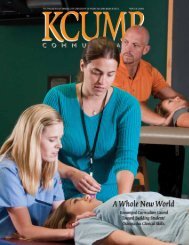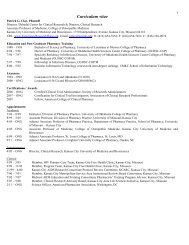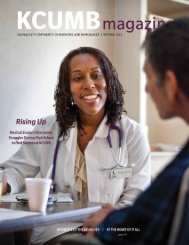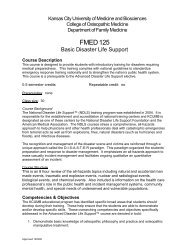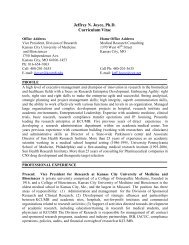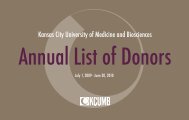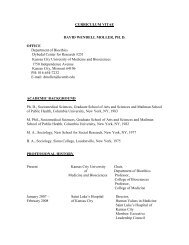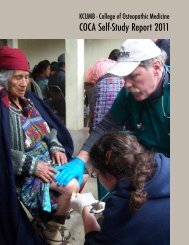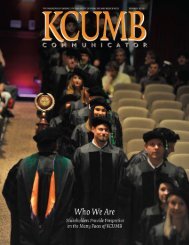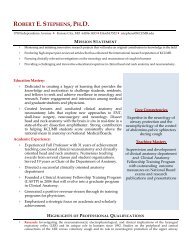2009-2010 KCUMB College Catalog - Kansas City University of ...
2009-2010 KCUMB College Catalog - Kansas City University of ...
2009-2010 KCUMB College Catalog - Kansas City University of ...
Create successful ePaper yourself
Turn your PDF publications into a flip-book with our unique Google optimized e-Paper software.
medical practice and are especially important in the evaluation and treatment <strong>of</strong><br />
the musculoskeletal system.<br />
The development <strong>of</strong> palpatory skills and grasp <strong>of</strong> osteopathic treatments are<br />
acquired in the first- and second-year labs <strong>of</strong> medical school. This learning<br />
requires active participation in all laboratory sessions. During the first two years,<br />
each student will palpate, in the laboratory setting, a variety <strong>of</strong> people,<br />
representing both genders and individuals with different body types to simulate<br />
the diversity <strong>of</strong> patients expected in a practice setting. Being palpated by other<br />
students helps the student appreciate how palpation feels from the patient’s<br />
perspective and enables the students to provide feedback to their laboratory<br />
partners, thus enhancing the palpatory skills <strong>of</strong> all students.<br />
The osteopathic medical pr<strong>of</strong>ession uses a variety <strong>of</strong> treatment models, and<br />
through the skills development process, the student learns the art and skills <strong>of</strong><br />
manipulative treatment. Psychomotor skills are developed by repeated practice.<br />
Reading and observation, although helpful, do not develop the skills required to<br />
perform palpatory diagnosis and manipulative treatment. Each student is<br />
required to actively participate in all skill development laboratory sessions. These<br />
skills are taught by treating and being treated by a cadre <strong>of</strong> students <strong>of</strong> both<br />
genders and with varying body types to simulate a medical practice setting.<br />
Proper dress attire is an important aspect <strong>of</strong> manipulation training in the<br />
laboratory setting. The development <strong>of</strong> palpatory skills needed to diagnose and<br />
treat problems <strong>of</strong> the musculoskeletal system requires dress attire to maximize<br />
the ability to evaluate tissue texture changes, bony and s<strong>of</strong>t tissue landmarks,<br />
tenderness and range <strong>of</strong> motion. All students should wear loose fitting shirts and<br />
short pants/scrubs/sweats/bathing suits (no spandex) to the laboratory to allow<br />
easy access for palpation <strong>of</strong> body parts as determined by particular subject area <strong>of</strong><br />
each lab (for example, if the cervical spine is being examined, then regular street<br />
clothes which allow complete access to the cervical area may be worn). To allow<br />
maximal exposure <strong>of</strong> the back, female students should wear a sports bra or<br />
bathing suit top under a loose fitting shirt. All students should keep their shirts<br />
on unless being directly palpated. Improper attire includes items that might<br />
impede palpatory and visual learning, including, but not limited to: denim, cut<strong>of</strong>fs,<br />
jewelry and belts. To help keep the tables clean and prevent tearing <strong>of</strong> the<br />
covers, it is especially important that shoes not be worn while on the tables.<br />
Scrubs may be worn in the lab with the caveats above. All scrubs should be in<br />
good repair and clean.<br />
Occasionally, a student may present with a physical problem that may<br />
contraindicate a specific type <strong>of</strong> manipulation in a specific anatomical location. A<br />
student who feels manipulation might be contraindicated is required to contact<br />
44




